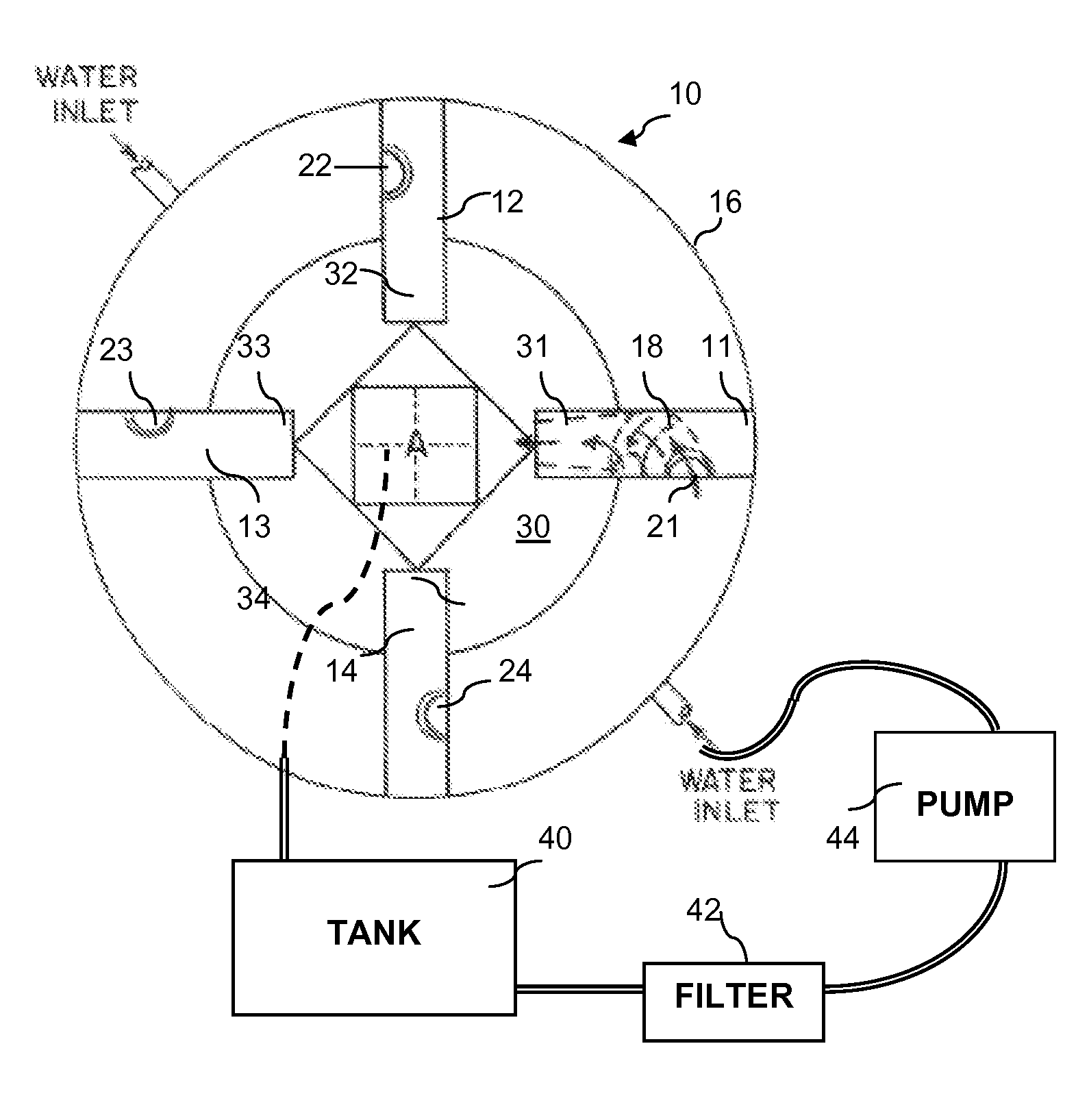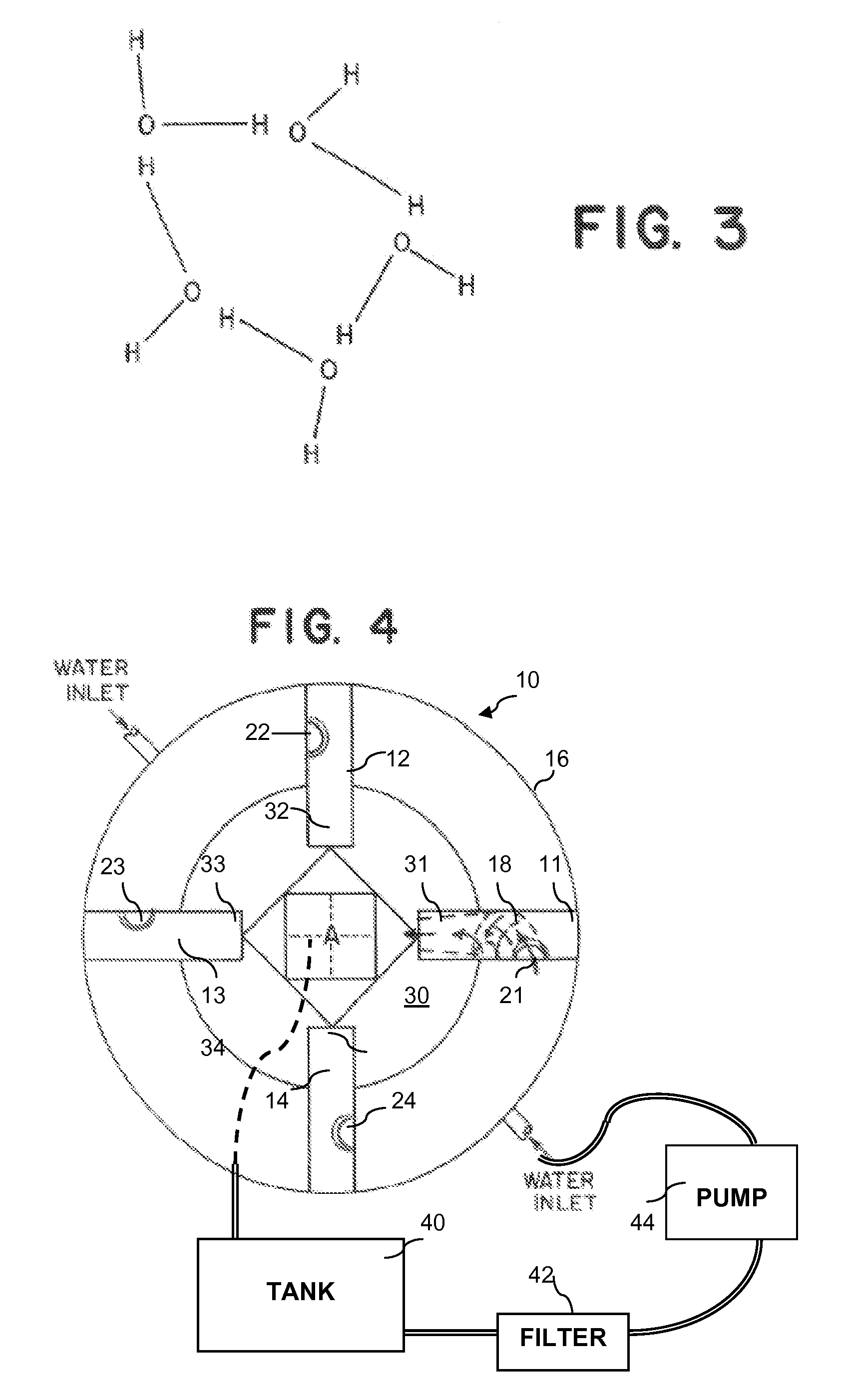System for producing micro-cluster liquids
a technology of micro-cluster liquid and process, applied in the direction of fuel injection apparatus, mixer accessories, inorganic non-active ingredients, etc., can solve the problem of distorting the individual envelope of intra-atomic molecular orbital configuration, and achieve the effect of reducing agitation and slowing down the london forces
- Summary
- Abstract
- Description
- Claims
- Application Information
AI Technical Summary
Benefits of technology
Problems solved by technology
Method used
Image
Examples
example 1
How to Make Micro-Cluster Water
[0036]Described below is one example of a method for making micro-cluster liquids. Those skilled in the art will recognize alternative equivalents that are encompassed by the present invention. Accordingly, the following examples is not to be construed to limit the present invention but are provided as an exemplary method for better understanding of the invention.
[0037]325 gallons of steam distilled water from Culligan Water or purified in 5 gallon bottles at a temperature about 29 degrees C. ambient temperature, was placed in a 316 stainless steel non-pressurized tank 40 with a removable top for treatment. The tank was connected by bottom feed 2¼″316 stainless steel pipe that is reduced to 1″ NPT into a 20″ U.S. filter housing 42 containing a 5 micron fiber filter, the filter serves to remove any contaminants that may be in the water. Output of the 20″ filter is connected to a Teel model 1V458 316 stainless steel Gear pump 44 driven by a 3HP 1740 RPM ...
example 2
[0046]The following are reports from individuals who used the water of the invention.
Elimination Of Edema:
[0047]Patient A: A 66-year-old Male presenting with (ALS) Amyothrophic Lateral Sclerosis (Lou Gherig's Disease) exhibited a shoulder hand syndrome with marked swelling of the left hand. This hand being the predominately affected limb. After consuming 500 ml of Penta-hydrate™ micro-cluster water the swelling of the left hand was dramatically reduced to normal state. Additional tests were accomplished over several weeks noting the same reduction of edema after consuming Penta-hydrate™ micro-cluster water. When Penta-hydrate™ was discontinued edema reoccurred overnight, upon consuming 500 ml of Penta-hydrate™ micro-cluster water edema was reduced within 4 to 6 hours.
[0048]Patient B: Is a 53 year old female with multijoint Acute Rheumatoid Arthritis of 6 year duration. She has been taking diuretics for dependent edema on a daily basis for 4 years. She began taking Penta-hydrate™ Mic...
example 3
[0080]A novel water prepared by the method of the invention was characterized with respect to various parameters.
A. Conductivity
[0081]Conductivity was tested using the USP 645 procedure that specifies conductivity measurements as criteria for characterizing water. In addition to defining the test protocol, USP 645 sets performance standards for the conductivity measurement system, as well as validation and calibration requirements for the meter and conductivity. Conductivity testing was performed by West Coast Analytical Service, Inc. in Santa Fe Springs, Calif.
Conductivity Test Results
[0082]
Micro-clusterMicro-clusterw / O2RO waterwaterwaterConductivity at 25° C.*5.553.163.88(μmhos / cm)*Conductivity values are the average of two measurements.
[0083]The conductivity observed for the micro-cluster water is reduced by slightly more than half compared to the RO water. This is highly significant and indicates that the micro-cluster water exhibits significantly different behavior and is there...
PUM
| Property | Measurement | Unit |
|---|---|---|
| liquid temperature | aaaaa | aaaaa |
| pressure | aaaaa | aaaaa |
| pressure | aaaaa | aaaaa |
Abstract
Description
Claims
Application Information
 Login to View More
Login to View More - R&D
- Intellectual Property
- Life Sciences
- Materials
- Tech Scout
- Unparalleled Data Quality
- Higher Quality Content
- 60% Fewer Hallucinations
Browse by: Latest US Patents, China's latest patents, Technical Efficacy Thesaurus, Application Domain, Technology Topic, Popular Technical Reports.
© 2025 PatSnap. All rights reserved.Legal|Privacy policy|Modern Slavery Act Transparency Statement|Sitemap|About US| Contact US: help@patsnap.com



